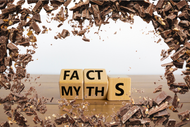Clearing Up Common Chocolate Myths
Sep 1st 2025
Although chocolate is loved by all people worldwide, the way it is discussed can be perplexing. What does the term "raw cacao" mean? What does "ceremonial grade" mean? Many terms that are becoming more and more common are being used, which leads to misunderstandings.
As cacao suppliers with generations of experience, we are aware of how perception is influenced by language. In order to help crafters and ingredient purchasers see past marketing jargon, this blog aims to dispel some of the most prevalent myths surrounding cacao.
The goal of this blog is to offer clarity, not to shame or criticize. We are aware that a lot of these terms are now so commonly used that they are frequently being requested by customers.
Cocoa vs. Cacao: What’s the Difference?
In technical terms, they all refer to Theobroma cacao, the same plant. The distinction is merely linguistic. It is called "cocoa" in English and "cacao" in Spanish. "Cacao" is often used to refer to the raw ingredient because it often comes from Spanish-speaking nations. The term "cocoa" is now frequently used to describe processed ingredients, such as powder, or final goods, such as hot cocoa.
Consequently, "cocoa" and "cacao" have the same chemical meaning; people simply became accustomed to using them in different contexts.
However, just as "cocoa" does not always imply that something is refined or sugary, calling something "cacao" does not imply that it is unprocessed. Therefore, it is always preferable to consider the product's manufacturing process and the steps it has undergone rather than depending solely on terminology. It's not just the label that defines quality and purity.
The Truth About “Raw” Cacao
“Raw cacao” sounds beautiful, pure, healthy and powerful. It is a staple buzzword in the wellness space. But, from a technical standpoint, it’s a misleading claim.
Fermentation generates heat, exceeding the “raw food” limit which is usually defined as 42°C. Fermentation is a crucial step in cacao processing because it transforms the raw, extremely bitter and astringent beans into flavorful, safe ingredients for chocolate to be born. The complex biochemical reactions that occur during fermentation are what lay the foundation for chocolate’s characteristics: Sugars and pulp are broken down into alcohol and acids, and enzyme activity is triggered. The rise in heat also helps to kill many pathogens and lower the pH, which inhibits microbial growth.
Without fermentation, chocolate would not taste like chocolate. It wouldn’t look like it, either! Fermentation transforms the bean from a purple color to the brown color we all recognize.
After fermentation the beans are dried, often under direct sunlight, which again exceeds the “raw food” temperature limit.
Truly raw cacao would have to be unfermented, flavorless, and microbiologically risky.
Many suppliers use the term “raw” to describe cacao that is minimally processed, but it’s important to keep in mind that it is not a scientifically accurate term. Since the labeling isn’t regulated, (there isn’t a formal or international standard for it) the term is used loosely.
Ceremonial Cacao — Is There a Standard?
Ceremonial cacao is a term that is gaining popularity. For many, it simply refers to cacao liquor (also known as cacao mass or cacao paste) that is used in cacao ceremonies for spiritual purposes. For others, it is a branding term that shows a high-quality, minimally processed cacao.
The truth is, there is no official body to certify what “ceremonial grade” actually means. There are no standards on origin or processing that would define cacao as ceremonial. Companies simply define it based on their own values. This doesn’t mean that the label is meaningless or negative in any way, it simply means that it’s subjective. For example, some suppliers may consider their cacao ceremonial grade because it is minimally processed and from a small sustainable farm, while others may consider it ceremonial grade because of its spiritual or energetic aspects.
Is Cacao Butter Cold-Pressed?
Another common claim in cacao marketing is that the butter is cold-pressed, suggesting a raw, nutrient-dense process. Unfortunately, cacao beans are not olives. The fat doesn’t simply fall off a cacao bean by squeezing it. Cacao butter must be extracted mechanically. Although it can be done without solvents (we never use solvents at CocoaSupply) the process still does involve heat — usually between 90–100°C — because the cacao paste must be warm enough for the fat to separate.
What Does Matter?
If labels like “raw” or “ceremonial” are flexible, what should makers and buyers actually look for when evaluating quality cacao?
Here are the real markers of quality:
Transparent origin – Country, region, and farm-level sourcing info
Direct or fair trade relationships – With proof of ethical labor practices
Post-harvest details – Fermentation method, drying, roasting, deodorization methods
Lab testing – For microbiological safety
Processing method clarity – Pressed vs. solvent-extracted butter, etc.
These are the elements that shape flavor, safety, shelf stability, and ethics. As more makers explore the nuances of chocolate, we believe it’s important to honor the truth behind the terms.

